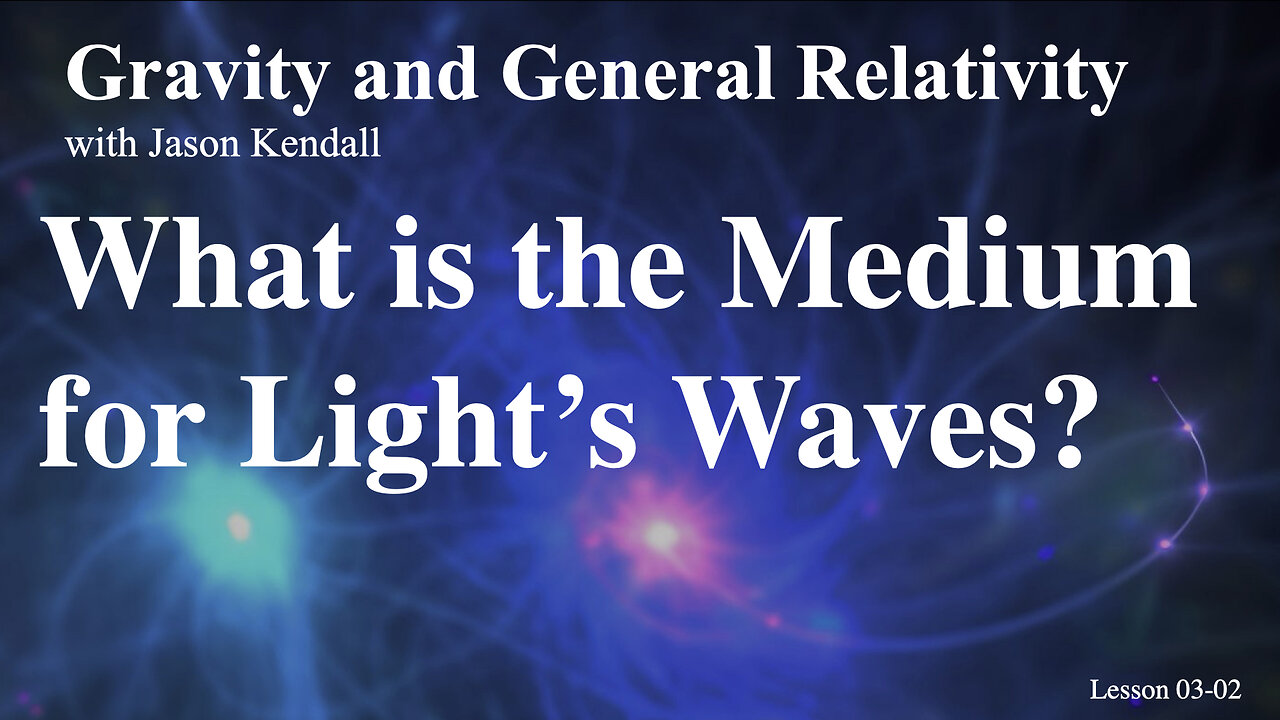Premium Only Content

The Journey of Light: From Ether to Electromagnetism
In this lecture, we embark on a journey to unravel the intricate history of light and its significance in our understanding of the universe. While this exploration may seem tangential to astronomy at first, it is crucial to recognize that light serves as our primary messenger from celestial bodies. The distances involved in astronomy are staggering: the Moon is approximately 200,000 miles away, the Sun about 93 million miles, Jupiter five times that distance, and stars are measured in light-years. Given these vast separations, comprehending how light behaves and interacts with matter is essential for interpreting the cosmos. Our inquiry begins with the establishment of the wave theory of light, which gained prominence in the 19th century with the work of James Clerk Maxwell. Maxwell’s equations characterized light as a propagation of electromagnetic waves, asserting that light could exist at various wavelengths and frequencies, all of which are interrelated through the speed of light. However, this leads us to two fundamental questions: what is the speed of light, and what medium does it traverse? Historically, every wave theory necessitated a medium for propagation; for instance, sound waves require air, and water waves necessitate water. Thus, it was assumed that light also needed a medium through which it could travel. This hypothetical medium was termed the luminiferous ether, which was believed to fill the cosmos and facilitate the transmission of light without being affected by matter. The concept of the luminiferous ether became a cornerstone of 19th-century physics, leading to the belief that the Earth moved through this stationary ether. To investigate this idea further, scientists sought to determine the speed of the Earth through the luminiferous ether. In 1887, Albert A. Michelson and Edward W. Morley devised an ingenious experiment utilizing an interferometer. Their apparatus involved splitting a beam of light using a half-silvered mirror, directing the two resulting beams along perpendicular paths, and then recombining them to observe any interference patterns. If the Earth was indeed moving through the luminiferous ether, one beam would encounter an ether wind, leading to a measurable phase difference between the two beams. Despite meticulous experimentation and calibration, Michelson and Morley found no evidence of the expected interference pattern that would indicate an ether wind. Their results indicated that the speed of light was constant, regardless of the Earth’s motion through space. This groundbreaking finding posed a significant challenge to the ether hypothesis and prompted a reevaluation of the nature of light. Before delving deeper into the implications of the Michelson-Morley experiment, we must explore earlier attempts to measure the speed of light. In 1638, Galileo Galilei attempted to gauge the speed of light by employing lanterns placed atop hills. He discovered that the speed of light was too fast for his timing methods, concluding that if it was not infinite, it was exceedingly rapid. A few decades later, in 1676, the astronomer Ole Rømer provided a more quantitative estimate of the speed of light by timing the transits of the Galilean moons of Jupiter. He noted discrepancies in the predicted transit times, attributing these variations to the finite speed of light and the changing distance between Earth and Jupiter as Earth orbited the Sun. Rømer’s calculations yielded an approximate speed of light of about 220,000 kilometers per second. Fast forward to 1728, when James Bradley conducted experiments on stellar aberration, leading to a refined measurement of the speed of light at about 300,000 kilometers per second. His work demonstrated the effects of Earth’s motion on the observed positions of stars, further supporting the notion of a finite speed of light. In 1850, Hippolyte Fizeau employed a rotating mirror and a beam of light to measure the speed of light in air and water, providing additional confirmation of light’s rapid propagation. Finally, by the turn of the 20th century, Louis Essen and Gordon Smith utilized electronic methods to measure the speed of light with remarkable accuracy, establishing it at approximately 299,792 kilometers per second. Returning to the Michelson-Morley experiment, the absence of a detectable ether wind suggested that the luminiferous ether could not exist as previously conceived. This pivotal moment in scientific history prompted Albert Einstein to propose his theory of special relativity in 1905, which eliminated the need for an ether and established that the speed of light is constant in all inertial reference frames. In conclusion, the exploration of light’s nature has been shaped by a series of key discoveries and experiments, from the early attempts to measure its speed to the revelations that emerged from the Michelson-Morley experiment. The development of the wave theory of light and the subsequent understanding of light as an electromagnetic wave fundamentally transformed our comprehension of the universe and laid the groundwork for modern physics. As we continue to investigate the properties of light, we recognize its significance as our primary means of understanding the cosmos.
-
 56:11
56:11
X22 Report
2 hours agoMr & Mrs X - Women Are Fighting Back Against Men In Women's Spaces, It Has Begun - EP 15
23.1K7 -
 20:46
20:46
Jasmin Laine
1 day agoJoe Rogan Drops NUKE—Carney’s Secret Deal + 100,000 Kamloops Homes at Risk
6.67K23 -
 4:00
4:00
Mrgunsngear
1 day ago $17.61 earnedFirst They Came For Glock, Now They're Coming For The Ruger RXM
18.3K17 -
 1:42:46
1:42:46
Lara Logan
1 day agoINJECTING TRUTH INTO THE VACCINE DEBATE with Del Bigtree | Ep 43 | Going Rogue with Lara Logan
13.3K31 -
 12:55
12:55
Cash Jordan
19 hours agoNYC Busses 'MOBBED' by Millionaires... as "Communist" Mayor VOWS to END AMERICA
8.86K26 -
 LIVE
LIVE
Major League Fishing
1 day agoLIVE! MLF Toyota Series Championship!
580 watching -
 18:54
18:54
Bearing
1 day agoNew York COMMUNIST TAKEOVER 🚨 Zoran Mamdani’s Revolution 💥
10.9K77 -
 1:05:26
1:05:26
Man in America
1 day ago“Poseidon” Doomsday Sub, Microplastics & The War on Testosterone w/ Kim Bright
45.2K55 -
 12:15
12:15
Degenerate Jay
21 hours agoIs GTA 6 In Trouble?
3.27K -
 LIVE
LIVE
FyrBorne
15 hours ago🔴Battlefield 6 Live M&K Gameplay: Who's Hunting Who?
579 watching